NOTE: Thank you to the Westminster Abbey who have given permission for this EarthCache to be sited here. This EarthCache is located within an area frequently patrolled by Police. Please avoid acting suspiciously whilst completing the Tasks, and, if challenged, please freely explain about geocaching. It may be worth pointing out that it is not a physical box you are looking for, but are simply studying the building visible to everyone.
To get your smiley for the cache, e-mail or send a message through the message center with your answers for the questions below to the cache owner. This EarthCache is located outside Westminster Abbey and the questions can be answered standing outside the gate without paying the entrance fee. However, if you would like to pay the entrance fee and go in more examples of the stones explained below can be seen inside.
Westminster Abbey is more than a thousand years old and has experienced many changes through the years. Monks first came to the site in the middle of the tenth century. In 1066 The Abbey began its rich history of coronations and burial grounds for monarchs and significant people. In 1245 the present Abbey structure construction was commissioned by Henry III. The stones at Westminster Abbey tell a story of history and here at The West Front examples can be seen from the ages.
Reigate Stone
Reigate stone is found in the Upper Greensand beds in Surrey. The outcrop runs from east to west and centers in the town of Reigate. In days past the stone was extracted from underground quarries and transported north to London. Since The Crown owned the quarries, the Royal Palaces and many other high status and medieval buildings in London were made with Reigate stone.
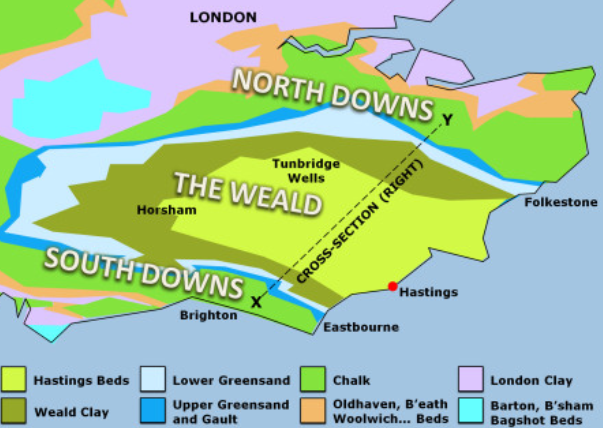
Reigate stone is fine grained with a yellow-grey color when dry and a green-grey color when wet. It has a scaly weathering and when the sunlight hits it one can see sparkles in it.
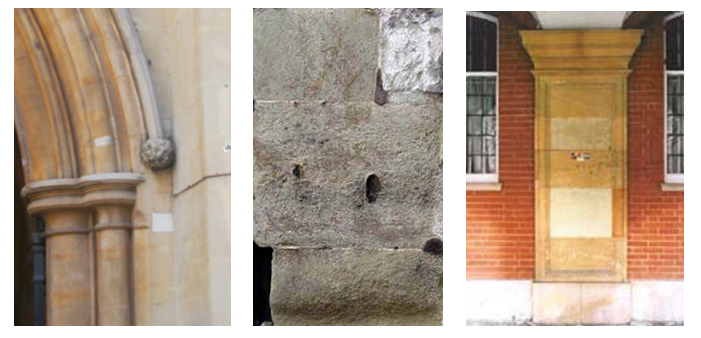
Reigate has a small clay content which makes it smooth and easy to carve into almost any shape. This property, however, also lends to the stones’ unfortunate ability to decay upon exposure to the atmosphere. In 1713, Sir Christopher Wren described the behavior of the stone at the Westminster Abbey: “That which is to be most lamented, is the unhappy Choice of Materials, the Stone is decayed four Inches deep, and falls of perpetually in great scales.” The root cause of the poor weathering according to Wren was that “this Stone takes in Water, which being frozen, scales off, whereas good Stone gathers a Crust, and defends itself”. Most of the Reigate stone in London has been replaced, however, there are modern conservation approaches being used now to preserve the little Reigate stone left. Some examples of the original 1243 AD stone still exist on The West Front of the Westminster Abbey and inside around the annunciation door in The Chapter House.
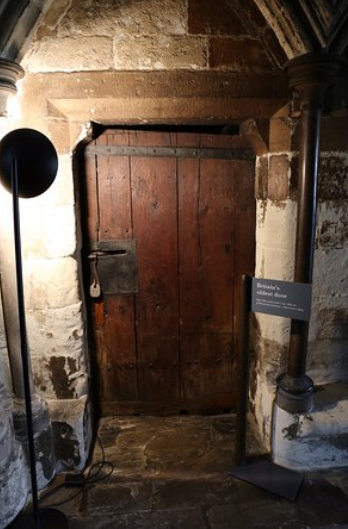
Portland Stone
After the great fire of 1666 Sir Christopher Wren suggested that Portland stone was more suitable for the atmosphere of London. Portland Limestone is from the Isle of Portland, Dorset located in the English Channel.
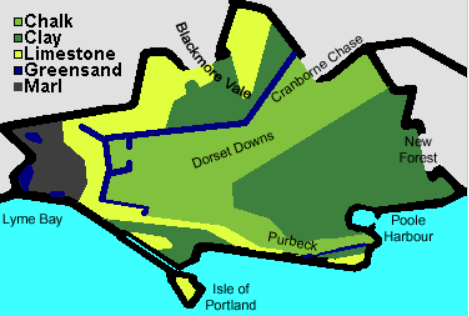
Portland stone is grey and white. It contains fossils of oysters and is an oolitic limestone. Upon close inspection of the stone oolites, or egg shaped circles, can often be seen.
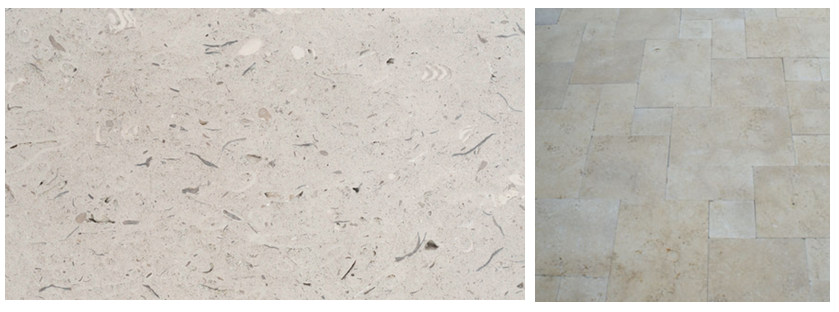
Portland stone is highly cemented which allows it to resist weathering, but not so well cemented that it cannot be carved. Due to the conditions of London with the heavy traffic causing rumblings, dampness from the rain, and acid, the original Reigate stone has peeled away over the years like damp wallpaper. In the 1700’s a major Westminster Abbey restoration project began with the replacement of Reigate stone with Portland stone. During this time the western towers on The West Front were completed in 1745 and were entirely constructed of Portland stone. Due to the age of the building and number of visitors to Westminster Abbey it is in constant repair and even new additions are made. In 1993 the western towers were restored and soon after, a new stone was introduced to The West Front in the form of statues.
Richemont Limestone
The ten new statues on The West Front are carved from Richemont Limestone. Richemont Limestone can be a light beige or grey color and quarried in Bordeaux, France. It is a moderately porous limestone and weathers well over years.
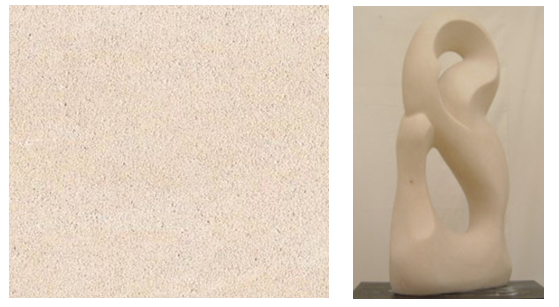
These ten statues are Christian martyrs of the 20th century who have died in circumstances of oppression or persecution. The statues took nearly 5 years to carve out of this durable limestone by 4 different sculptors. In 1998 the statues were finished and they filled the ten vacant statue niches on the façade above the Great West Door. The statues are from various denominations. Those commemorated are Maximilian Kolbe of Poland, Manche Masemola of South Africa, Janani Luwum from Uganda, Grand Duchess Elizabeth of Russia, Martin Luther King Jr. of the United States of America, Óscar Romero of Salvador, Dietrich Bonhoeffer of Germany, Esther John of Pakistan, Lucian Tapiedi of Papua New Guinea, and Wang Zhiming from China. As you can see, even now the stones of Westminster Abbey continue to tell as story as they have through the ages.
Thank you for visiting this EarthCache. Please send your answers to the questions to the cache owner through the message center or email. In your "found it" log feel free to write about your experience, but don't include the EarthCache answers. When answering the questions do your best. It is more important that you learn a new concept about our earth and can apply your knowledge rather than have a precise answer. Questions are to be answered by visual observations only. Please do not touch the stones of the Abbey. Thanks and we hope you enjoy the inspiring Westminster Abbey!

Questions:
1- Please write Westminster Abbey, tell us how many people are in your group, and if the weather is wet at the time of your visit.
2- Where do you see an example of Reigate stone on The West Front? Describe the stone in terms of color and composition.
3- Where do you see an example of Portland stone on The West Front? Describe the stone in terms of color and composition.
4- Where do you see an example of Richemont Limestone on The West Front? Describe the stone in terms of color and composition.
5- On a scale of 1-5 (1 = West Front stones are breaking apart and 5 = West Front stones are in perfect condition) rate what you believe the current condition level of the stones are. Give your reasoning for your answer.
Sources:
http://www.westminster-abbey.org/our-history/architecture
http://www.bgs.ac.uk/discoveringGeology/geologyOfBritain/holidayguides/westminster.htm
www.discoveringfossils.co.uk
http://www.canterbury-archaeology.org.uk/stones-reigate/4593809508
https://www.cs.mcgill.ca/~rwest/wikispeedia/wpcd/wp/g/Geology_of_Dorset.htm
http://www.croydoncavingclub.org.uk/node/391
http://www.kgarch.co.uk/projects/reigate/reigate2000.html